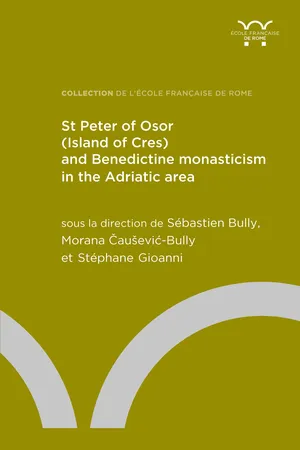
St Peter of Osor (Island of Cres) and Benedictine monasticism in the Adriatic area
- English
- ePUB (mobile friendly)
- Available on iOS & Android
St Peter of Osor (Island of Cres) and Benedictine monasticism in the Adriatic area
About this book
This book gathers the proceedings of the international round-table Saint-Pierre d'Osor et le monachisme bénédictin dans l'espace adriatique held in 2018 at Osor on the island of Cres (Croatia), which marked the culmination of twelve archaeological campaigns (2006-2017). The aim of this meeting was to present and contextualise, on a broad geographical and chronological scale, our knowledge of the monastery of St Peter and Benedictine monasticism in the Adriatic, whose importance in the reform of the Church in the 11th century was magnified by the Camaldolese Annals in the 18th century. This multi-disciplinary study of St Peter of Osor and its representations allows us to compare the available sources (archaeological, literary and archival) and to renew our understanding of the island monastery, its presumed foundation by Gaudentius, bishop of Osor and then monk at the Porto Novo monastery in Ancona, and its role in the implementation of the reform. It also sheds new light on Benedictine expansion, the spread of monastic culture, artistic transfers, the movement of people and networks of sociability between the shores of the Adriatic. Finally, it examines the dialogue between archaeology and history.
Frequently asked questions
- Essential is ideal for learners and professionals who enjoy exploring a wide range of subjects. Access the Essential Library with 800,000+ trusted titles and best-sellers across business, personal growth, and the humanities. Includes unlimited reading time and Standard Read Aloud voice.
- Complete: Perfect for advanced learners and researchers needing full, unrestricted access. Unlock 1.4M+ books across hundreds of subjects, including academic and specialized titles. The Complete Plan also includes advanced features like Premium Read Aloud and Research Assistant.
Please note we cannot support devices running on iOS 13 and Android 7 or earlier. Learn more about using the app.
Information
Table of contents
- Introductory pages
- Table of contents
- Introduction
- Introduction
- Part 1. Saint Peter of Osor in the Adriatic contex
- Part 2. Gaudentius and the Monastery of Saint Peter of Osor: origins and legacy
- Conclusions
- Conclusions